fc227@connix.com
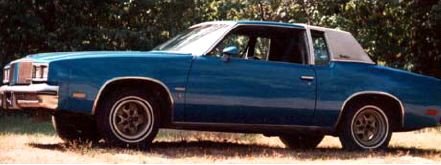 Here are some tips on the pre-fuel injection cars covering the years from 1978-1983 . This is what I did to get my car from 18.988@79.32 to 14.19 @ 93.00 mph.
Here are some tips on the pre-fuel injection cars covering the years from 1978-1983 . This is what I did to get my car from 18.988@79.32 to 14.19 @ 93.00 mph.
My car is a 1980 Olds Cutlass , with a 1981 turbo Buick V-6. It weighs 3440 lbs. with me in it. (I weigh 200 lbs), TH350 tranny, started with 2.27 gears (car came with them ) and switched to 3:42 & posi., stock turbo, stock carb, stock longblock (rebuild by APR out of California), available at Parts Plus stores.
Not all the info I am sharing with you will have to be done with your Buick because it's probably already there. (e.g.. high gear ratio, etc.).
The bigger rear end (the 8 1/2) , will bolt up in your car. That would be the strongest , But I opted for a different solution. In the 7 1/2 rear end , the stonger 7-5/8 posi center section will fit. (out of a Chevy S-10) . You will have to change the pinion gear also. If you are not comfortable doing this, bring it to someone who is. I am running 3.42 gears with a GM factory Auburn (used in the S-10s). I picked mine up at a junk yard for $50.00 (out of a truck 2 years old that snapped an axle).
If you already have gears in the 3.23 / 3:42 range, you might just want to get a posi center section. This is a big plus for traction. Air bags in the spring work well for wheel hop, but the best solution is to replace the bushings in the rear control arms. This is a 99 percent cure for wheel hop.
For tires I am running a pair of skinny 14 inch bias ply in front & Mickey Thompson G60 x 14" in the rear. These tires grip great when they are heated up & they are D.O.T. approved.
Also install the bigger wheel cylinders to help hold the boost at the line. And you will need a line lock because this makes it much easier to do a burnout . (Thats half the fun of racing!)
Check your universals joints and replace if necessary.
Shift kits are a big plus. I had a local tranny shop rebuild mine and they put the extra clutch packs in, new pump, etc. Also install a tranny cooler. This is very important if you are racing all day, loading the car against the brake, and making a quarter mile blast. You have got to get the heat out of the tranny.
Adjust the modulator to shift around 4500 RPM .
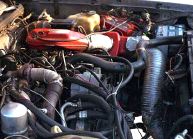 Use fresh synthetic oil and an AC PF52 or PF47 oil filter. I change mine when it starts going black . (About once a month or 2000 miles with about 10- 20 runs on it).
Use fresh synthetic oil and an AC PF52 or PF47 oil filter. I change mine when it starts going black . (About once a month or 2000 miles with about 10- 20 runs on it).
Replace your air filter with a K&N because they flow very well, and they can be cleaned and reused. Also replace the crankcase vent filter and PCV valve .
Now we want cool air going into the engine. I made my own fresh air / ram air by using a furnace hot air register and some 4" aluminum dryer hose with duct tape. I mounted the register scoop under the radiator support, fed the hose up to the air canister, and formed the hose to fit to the opening of the can. It seems to work well . I am going to try a 4" cone filter soon.
As for the carburetor, this is where you can pick up some power , If its old and crudded up consider a rebuild. Replace the needle valve and seat with one that is used for the older trucks. It has holes in the side to allow more fuel in when the float is open.
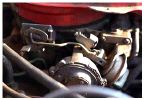 Getting the secondaries to open faster makes more power and boost against the brake.
Getting the secondaries to open faster makes more power and boost against the brake.
To readjust the secondaries, you want the mechanical spring tension to be near zero. This is done by using a Allen wrench to loosen the set screw, then turn the tension screw to loosen the secondary spring tension. BE CAREFUL NOT TO GO MORE THAN ONE TURN , OR YOU MAY BREAK THE TAB THE HOLD THE SPRING.
This will allow the secondaries to open quicker, giving more power. Before I did this, the car would not spin the tires against the brake. After I adjusted the secondaries, I had no problem spinning those Mickey Thompsons.
For the accelerator pump, drill a other hole above the highest hole (closest to the center pivot point) and set your pump rod in this new hole. This will give you a extra shot of fuel when you nail the gas.
As for jetting the primarys, I would leave that alone because they are setup for emissions. The secondary jets are fixed in the bowl, but you can richen them by getting different hangers for the secondary metering rods or drill them with a bigger hole above the stock location (1/16" holes). Here again be careful, since a lot of this stuff is obsolete and can only be replaced by finding one at a junk yard. I am using a air/fuel mixture sensor to help me tune the carb.
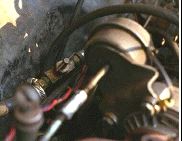 Set the carb too lean and the engine will ping, triggering the knock sensor, causing the engine will fall flat on its face. Too rich and you will foul the plugs and lose power. It's kind of a tight rope walk, but it can be done. Another thing we can do is to install a water shut off valve in line with the carbs plenums as shown in the photo. Turn it off in the summer and on in the winter for heat under the carb to prevent icing.
Set the carb too lean and the engine will ping, triggering the knock sensor, causing the engine will fall flat on its face. Too rich and you will foul the plugs and lose power. It's kind of a tight rope walk, but it can be done. Another thing we can do is to install a water shut off valve in line with the carbs plenums as shown in the photo. Turn it off in the summer and on in the winter for heat under the carb to prevent icing.
The intake gasket can have the exhaust cross over blocked off to reduce heating the manifold. An alternative is to use a gasket for the 1980 turbo engine, since it has a 5/8" hole to reduce intake heating, but still retain some heat for winter driving. This can be worth between 10-20 horse power. Here again the cooler the air into the engine the more power & more boost we can run.
For the turbo, the wastegate was set for around 8 to 10 pounds of boost . On every car but the 1981, shortening the rod will increase boost. On the 1981 the turbo has a normally open waste gate, so lengthening the rod will increase the boost. Make an adjustable rod, like shown in the photo below.
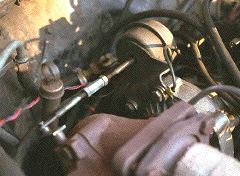
In either case, you need to have a good boost gauge and adjust in small increments. Nine pounds is about all we are going to get away with because we can not run a intercooler . After this point with a stock turbo it is going to make more heat than air . A few turns is all it takes.

After playing with the carb metering system , I can run 15 pounds of boost though mufflers on street gas (Sunoco 94) and 19 PSI with alcohol injection with no audible knocks . With this said, a knock alarm is not a bad idea. Below is a picture of the alcohol injection system attached to the top of the air cleaner.

As far as the ignition system goes, I have a stock knock sensor /HEI system that triggers a MSD 6AL unit. I really like this unit since it gives me a very hot spark. I replace the cap and rotor and use coil wound plug wires. The MSD will destroy the stock wires in short order.
For spark plugs I use Autolite 24 (or equivalent), gapped at a tight 0.040". I have the timing set at stock (16 degrees BTDC) with the vacuum advance disconnected. With racing fuel you probably can run a little more timing, but be careful. You don't want to burn a hole in a piston. It could be a long walk home!
I usa a 160 degree thermostat and I install an electric fan on a thermostat. The fan also turns on when the AC comes on. This saves a few horsepower.
For exhaust, I had a bigger down pipe made (2.5") and picked up 0.5 seconds! Headers off a 1983 will also help.
I few other options could be nitrous or a bigger turbo (with a high stall torque convertor).
I high recommend the books list below (Hot Rod @ a local library), very informative, shows lots of diagrams on to adjust the carb. ect.
- V-6 Performance
- by Pat Ganahl (S-A design books)
-
- ROCHESTER Carburetors
- by Doug Roe (HP books)
-
- Hot Rod Magazine
- (July 1979 /June 1981) very good articles on how to adjust the carb. etc.
-
- Parts & kits
- Borg/Warner 10619B (carb rebuilding kit)
AND a lot of testing and wrench turning !